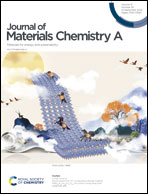ZIF-derived frame-in-cage hybrids of ZnSe–CdSe embedded within a N-doped carbon matrix for efficient photothermal conversion of CO2 into fuel†
Abstract
Solar photocatalytic CO2 reduction into valuable fuels shows great potential in solving the environmental and energy crises but remains a challenging goal. Herein, we present a strategy for the synthesis of frame-in-cage dodecahedral hybrids (ZnSe–CdSe@NC FC) composed of ZnSe–CdSe heterojunctions embedded within a nitrogen-doped carbon matrix through the simultaneous selenization and decomposition of a Zn-zeolitic imidazolate framework (ZIF-8) and the subsequent cation-exchange reaction with the assistance of ascorbic acid. The frame-in-cage microstructure of the dodecahedral particles can be obtained at a relatively low ramping rate (2 °C min−1). The conversion from ZnSe@NC FC to ZnSe–CdSe@NC FC and CdSe@NC FC can be realized by extending the cation-exchange reaction time with the assistance of ascorbic acid. In the ZnSe–CdSe@NC FC catalyst, the ZnSe–CdSe heterojunction and the unique frame-in-cage structure could provide effective mass/charge transfer, abundant active sites, and enhanced incident light utilization. Meanwhile, the high light-to-heat conversion ability of nitrogen-doped carbon realizes a photothermal synergistic effect throughout the photocatalytic process. These advantages make the ZnSe–CdSe@NC FC with optimized composition exhibit superior activity and high stability in photo-thermocatalytic CO2 reduction with a higher CO generation rate of 31.62 μmol h−1 g−1, which is much higher than that under single photocatalysis and thermocatalysis conditions. This work provides a promising strategy to design desired catalysts for photo-thermocatalytic CO2 reduction.



 Please wait while we load your content...
Please wait while we load your content...